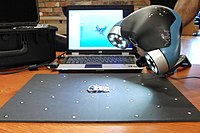
Photo from wikipedia
Accurate characterization of the form error for freeform optics is critical for controlled manufacturing and evaluation of optical properties. To solve the difficulty of current surface registration and fitting algorithms,… Click to show full abstract
Accurate characterization of the form error for freeform optics is critical for controlled manufacturing and evaluation of optical properties. To solve the difficulty of current surface registration and fitting algorithms, and improve characterization accuracy of the form error of freeform optics for optical point-based spatial path 3D topography metrology, in this paper, improved surface registration and fitting algorithms are proposed, including a B-spline surface description of freeform optics, point orthogonal projection, registration parameter optimization, and B-spline fitting. Limited by the angular characteristics of an optical point-based sensor, the slope and reference frame of freeform optics must be flexibly adjusted, and polynomial surfaces are described and fitted as B-spline surfaces based on B-spline geometric invariance. To efficiently determine corresponding points on B-spline surfaces, the point orthogonal projection algorithm without Bezier subdivision is proposed using the first-order Newton method. Then, the iteration procedure of coordinate adjustment in sphere space using Lie algebra registration parameters is proposed to solve the difficulty of the current registration parameter optimization procedure. To fit a spatial path form error, the least squares B-spline fitting method is proposed to improve the Zernike method. Through simulation experiments, the proposed registration algorithm with good convergence can improve accuracy by one to two orders of magnitude compared with current registration algorithms. Through repeated experiments of a freeform prism, the proposed method can significantly improve the peak-to-valley and RMS accuracies compared with the stylus method, and characterize the mid-high frequency form error (about 200 nm) of a freeform prism.
Journal Title: Applied optics
Year Published: 2022
Link to full text (if available)
Share on Social Media: Sign Up to like & get
recommendations!